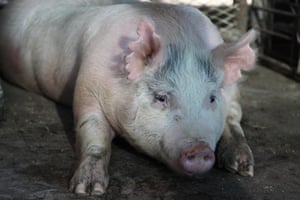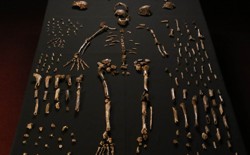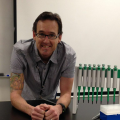
http://thescienceteacher.co.uk/objectives-in-science-lessons/ The problems with learning objectives in science lessons. Don't get me started. LOs are not a meaningful tool but they are required of teachers.
http://science.sciencemag.org/content/sci/352/6289/1052.full.pdf From this week's science magazine, a commentary by David Malkin et al about rare cancer predisposition syndromes which can identify genes that are critical to carcinogenesis. The Li-Fraumeni syndrome helped to identify a genetic defect that predisposed people to cancer in 1969. At that time cancer was not thought of as a genetic disease.
INSIGHTS
http://www.scientificamerican.com/article/is-intelligence-hereditary/ The Scientific American Mind blog on whether intelligence is hereditary. Genes explain 5% of the difference between people. A comment by Robert Plomin, a deputy director of the MRC Social, Genetic and Developmental Psychiatry Center at King’s College London.
http://www.smithsonianmag.com/innovation/kill-all-mosquitos-180959069/ This is an article from the Smithsonian about whether the gene editing technique recently developed should be used to eliminate carriers of malaria or Zika virus. It also refers to the interesting history of mosquitoes and disease.
http://science.sciencemag.org/content/sci/352/6289/1052.full.pdf
This is an article from this week's Science magazine about the identification in 1969 of a genetic syndrome later called the Li-Fraumeni Syndrome predisposing children to soft tissue cancers. This was before cancer was generally thought of as a genetic disease.
http://www.nature.com/polopoly_fs/1.19996!/menu/main/topColumns/topLeftColumn/pdf/534024a.pdf Here is a pdf from Nature describing research done at MIT to figure out how microbes carried in a sneeze travel.
https://www.theguardian.com/science/2016/jun/06/human-pig-embryos-qa-chimeras-transplant-organs-scientists This is an article from the Guardian about the creation of a human-pig chimera. This research was done at US Davis using CRISPR gene editing and will be advantageous for organ transplantation to minimize rejection. It was an NIH-funded study and the ethics of such work is being intensely debated. The bacon should be delicious.

http://www.nytimes.com/2016/06/07/upshot/the-us-is-failing-in-infant-mortality-starting-at-one-month-old.html?_r=0 This commentary is from the NYT and was developed from data from the CDC of infant and neonate mortality internationally and also from a publication of the American Economic Journal. The US does worse in terms of care for 1 month to 1 year olds than other countries. It is recommended that more money be provided to help mothers in poverty care for their newborns (under 1 year).

http://www.nytimes.com/2016/06/09/science/four-elements-on-the-periodic-table-get-new-names.html?_r=0 An article from the New York Times about the renaming of 4 chemical elements.
nihonium, moscovium, tennessine and oganesson replace ununtrium, ununpentium, ununseptium and ununoctium.

http://www.theatlantic.com/science/archive/2016/06/before-the-hobbits/485960/ From the Atlantic, a report of the finding of a human tooth and a jaw fragment from 700,000 years ago.These are from the hobbit lineage of dwarfed humans on the island of Flores.

http://www.sciencealert.com/scientists-have-developed-a-blood-test-that-detects-early-alzheimer-s-disease From ScienceAlert, a report of a blood test to detect early Alzheimers Disease. This is reported in the journal Alzheimers and Dementia. The test looks for autoantibodies.
http://www.sciencemag.org/news/2016/06/third-sex-lizards-could-outcompete-their-normal-female-cousins From Science magazine, this article reports about "superfemales". These are sex-reversed (as embryos) and their output of eggs is greater than normal females. Behaviorally, they are more like males than females and may possibly drive normal females to extinction.
http://www.the-scientist.com/?articles.view/articleNo/41702/title/A-Movable-Defense/ An article in The Scientist about transposable elements or jumping genes.
http://www.nature.com/articles/srep27523 Article in Nature about fish recognition of human faces. These are animals with no neocortex which learn to recognize a human face. Work was done at the Max-Planck Institute for Biological Cybernetics.
http://blogs.scientificamerican.com/artful-amoeba/natural-history-is-dying-and-we-are-all-the-losers/
An article in the latest Scientific American about the reduction in the number of course offerings in Natural History for a major in biology and the proportion of intro biology texts devoted to natural history since 1935. The commentator, lamenting the reduction, is a science writer.
http://www.newswise.com/articles/inbred-neanderthals-left-humans-a-genetic-burden In the blog Genes to Genomes there is a report of a publication in the journal Genetics about the genomes of Neanderthals. There is evidence that there are harmful mutations in the Neanderthal genome that left then 40% less reproductively fit than modern humans, (in other words, 40% less likely to reproduce and pass on their genes.)
http://www.nytimes.com/2016/06/09/science/national-academies-sciences-gene-drive-technology.html Article in NYT about the National Academy of Sciences, Engineering and Medicine, recommending safely controlled field trials of the gene editing of species using the new technology called CRISPR despite possible risks to the environment. The photo shows gene-edited female mosquitoes.

http://hub.jhu.edu/2016/06/10/health-and-humanity-q-and-a-karen-kruse-thomas This is a book called Health and Humanity, chronicling 50 years of the history of the Johns Hopkins School of Public Health.
http://www.the-scientist.com/?articles.view/articleNo/46205/title/Building-Gene-Networks/ This article in the New Scientist reports research done at Rice University by synthetic biologists who built synthetic gene circuits which they then put into E. coli bacteria. This is a way to study naturally occurring gene oscillators (like those that have circadian oscillations) which are normally hard to study.
http://www.scientificamerican.com/article/obscure-disease-may-offer-backdoor-to-new-treatments-for-alzheimer-s-and-other-killers/ From Scientific American MIND blog, an article about an obscure disease called Supra Nuclear Palsy, the rare disease that killed Dudley Moore. An accumulation of tau protein characterizes this hard to diagnose and impossible to cure disease. A recent publication in Science Translational Medicine suggests that maybe tau protein is involved in Alzheimers and possibly SNP patients can be used to test therapies for Alzheimers, which affects far more people.
http://www.sciencealert.com/new-treatment-improves-pancreatic-cancer-survival-rate-for-the-first-time-in-decades From ScienceAlert, a new treatment for pancreatic cancer. The clinical trial results, which increased the 5-year survival rate for pancreatic cancer from 15-17% to 29% was reported at the American Society for Clinical Oncology meeting. It was a combo study with gemcitabine and capecitabine.
http://blogs.berkeley.edu/2016/06/10/trump-clinton-on-the-environment-a-handy-guide/ From the UC Berkeley Blog, a chart comparing Trump and Hillary on the environment.
https://mrdrscienceteacher.wordpress.com/2014/11/02/teaching-the-hypothesis/ A Facebook post by Paul Strode about hypothesis teaching and the correct and incorrect ways of doing it.

http://www.sciencealert.com/this-crazy-infographic-shows-just-how-much-of-the-ocean-we-don-t-see From ScieneAlert, an infographic about the ocean
http://www.vox.com/2016/3/17/11250962/proof-evolution-vestigial A video by Vox shared by IFLS about the proof of evolution: vestigial structures on your own bodies.
No comments:
Post a Comment